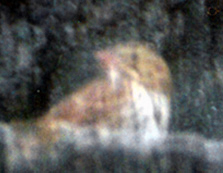Savannah Sparrow Passerculus sandwichensis

First recorded by Axel Braunlich Jürgen Fiebig and Michael Hoffmann, Nakdong estuary, Busan City, on February 18, 1998 (paper in prep.). 1, November 1st 2000, Gageo Island, Cheollanam Province; 1, presumed a different individual, November 7th-9th 2000, Gageo island.
On November 1st 2000, in heavy rain and Beaufort force 8 winds, a small and very skulking passerine was flushed several times out of short grass at Hang Ri headland on Gageo Island. Although it superficially resembled a very pale and streaky Rustic Bunting Emberiza rustica, it appeared smaller and had a shorter-looking tail that lacked white outer tail feathers. Views were very poor until it landed on some school steps, and bathed in a puddle. NM realized that this was a Savannah Sparrow (a species that he had significant experience of during several visits to the United States) and despite the weather conditions, attempted several photographs through a handheld camera through his telescope.
Notes taken at the time, and the resultant very poor images, confirm the species’ identification, based on (1) the lack of white in the tail (ruling out most buntings, including Yellow-browed Emberiza chrysophrys) and its (2) heavily streaked sandy-brown upperparts, lacking striking wingbars or any rufous or chestnut tones (ruling out most bunting species and Seaside Sparrow Ammodramus maritimus). In addition, it showed (3) a strongly marked facial pattern, with well-marked lateral crown stripes and weaker median crown stripe; (4) a strong "flared" whitish supercilium, becoming clearly yellow in the supraloral (amongst American sparrows a feature otherwise shared only by Seaside and Grasshopper Sparrows Ammodramus savannarum), and (5) dark moustachial and off-white broad submoustachial stripes, with (6) obvious blackish malar stipes (ruling out Grasshopper Sparrow); (7) heavy breast streaking, which formed a spot in the center of the breast. It (8) had a large pink bill (with darker grey upper mandible or at least culmen on closest views). Leg colour was not observed well, but was probably also pink. The bird called only once, a thin "sit".
Although searched for intensively later on the 1st, and again on the 2nd and 3rd, the bird could not be relocated, and considering the high turnover of migrants and the inclement weather was considered either to have died or to have migrated.
On November 7th, approximately 150 m uphill from the first sighting, another Savannah Sparrow was found. Although very skulking, it was re-found on the 8th and 9th, but not photographed or filmed. Although the weather was dry and bright, it is considered a different individual based mainly on the almost complete lack of yellow in the supraloral; a much weaker central breast spot; and as it was generally much paler-looking overall.
Based on Byers, Olsson and Curson (1995) identification as Savannah Sparrow is straightforward, but assigning either bird to subspecies is difficult, and ageing or sexing in the field is not possible after the post-juvenile moult (in July-September).
Some authors consider that there are as many as twenty-one races in four groups of allospecies within the superspecies. The Gageo Island Savannah Sparrows clearly belong to the "Savannah Sparrow Group", which nest in Alaska and winter southward into the western and southwestern United States, and even into Mexico.
Although the Savannah Sparrow is essentially an American species, it occurs as a regular vagrant on Wrangel Island (where it is suspected of breeding), and was found breeding at the extreme eastern end of the Chuchotka Peninsula in the early 1990s (Vladimir DINETS in lit.). It has been recorded at least fifteen times in Japan in winter, with extreme dates of October 18th and April 23rd (Nagata, H. and A. Ishimoto, 2000), with a maximum of six together in January and February 1988 (Brazil 1991). One bird was banded in April 1998, and was considered to be of the subspecies P. s. sandwichensis (Nagata, H. and A.Ishimoto, 2000).
In Japan, records during the late 1980s and early 1990s became almost regular in rice-fields at Izumi, Kagoshima Prefecture, Kyushu: a site, unlike most rice-fields in Japan, visited by very many birdwatchers as this is also the site for wintering White-naped Grus vipio and Hooded Cranes G. monacha. This suggests very strongly that the concentration of observers led to the concentration of observations, rather than any special habitat, leading further to the assumption that significantly more of the species probably migrate down the Japanese archipelago, and occasionally across the Korean peninsula, to winter at latitudes similar to those preferred in North America.



